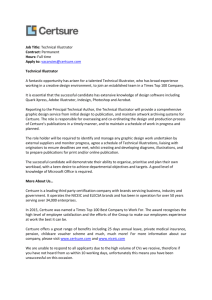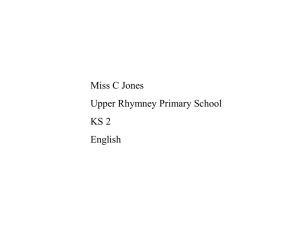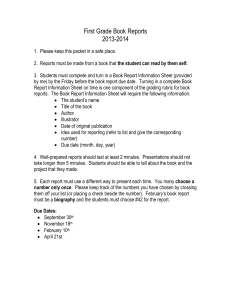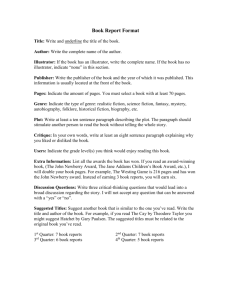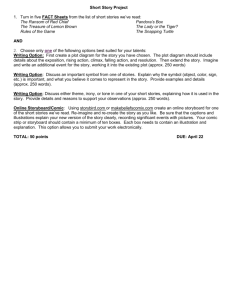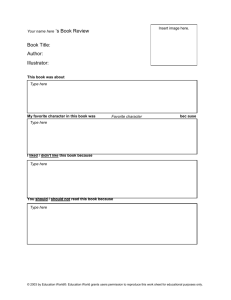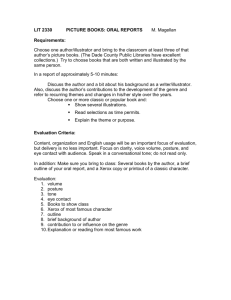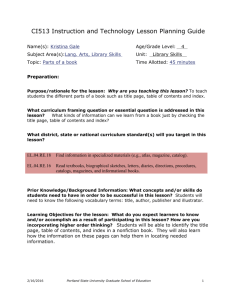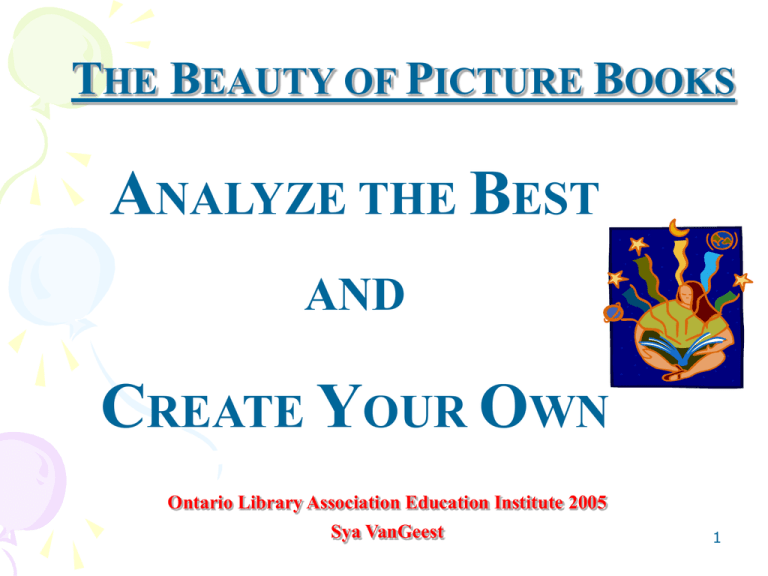
THE BEAUTY OF PICTURE BOOKS
ANALYZE THE BEST
AND
CREATE YOUR OWN
Ontario Library Association Education Institute 2005
Sya VanGeest
1
A Writer by M.B. Goffstein. New York: Harper & Row, 1984.
A writer sits on her couch holding an idea, until it’s
time to set words upon paper, to cut, prune, plan and
shape them.
She is a gardener, never sure of her ground,
or which seeds are rooting there.
She has grown flowers, weeds, a slender tree.
Now she dreams of pansies and heart’s-ease.
2
A Writer by M.B. Goffstein. New York: Harper & Row, 1984.
At first daylight, she sees two small green leaves
close to the soil.
If a rabbit eats them, she not mad at him.
She knows more will grow, for a writer always
studies, looks, and listens.
Thoughts that open in her heart, and weather
every mood and change of mind,
she will care for.
3
A Writer by M.B. Goffstein. New York: Harper & Row, 1984.
She’s only one of many writers, working alone at
her desk, hoping her books will spread the
seeds of ideas.
Sugar Bush by Pearl Van Geest
4
What makes a good picture book ?
• Stirs the imagination
• Tells a good story
• Uses beautiful language
• Pictures enrich the text
• It’s accurate in time & place
• Energized by strong words
• Shapes real characters
• Explores eternal verities
• It is engaging
• It is inviting
• Touches the heart
• It is fun
• Stimulates thought
• It is free from errors
• It’s appropriate for children
• Tells a dual story – in text and pictures5
OLA Teaching Materials
How do I begin?
Read and study many picture books
Study award-winning books
Blue Spruce Award
Caldecott
Governor General’s Award
First Choice
Examine their characteristic and qualities
great
What is
about these books?
The wonder of the story?
The beauty of the words?
The power of the art?
The enticement of the packaging?
6
Focus On Your Own Creation
Think and talk picture books
• discuss ideas with others
- family, friends, teachers, teacher-librarian
Be
inspired by picture books you read
Record possible story and art ideas
• Start a ‘fridge list’
• Add ideas as you think of them
Let ideas percolate in your mind
7
Share Picture Books With Children
Read aloud to children
Talk about the books
Notice children's responses K
L
o What did they like?
o In what way did it engage their emotions?
o How did it stimulate discussion?
o How did the pictures contribute to the story ?
Record ideas for your own book
8
Practice Good Time Management
• Break the process into parts
• Set due dates for each stage
• Use class time productively
• Schedule regular homework
• Meet all due dates
• Read picture books at every opportunity
OLA Teaching Materials
9
A STEP-BY-STEP PROCESS
•
Divided into
–
–
Record due dates for each part?
How will each part will be assessed and evaluated?
FIRST:
SECOND:
THIRD:
FOURTH:
FIFTH:
SIXTH:
six parts
Analyze qualities of good picture books
Plan proposal for your own creation
Write first draft of your story
Construct storyboard
Create final good copy
Present to a children’s audience
10
STEP 1: How to Analyze Picture Books
Study the Packaging”, Art and Story
Analyze Packaging, Art, Story Complete the Analysis sheets
1.
2.
Study six different picture books for
each focus (‘Packaging’, Art, Story)
3.
Write about two different books for each
Use jot notes or sketches
•
Packaging, Art, Story
Focus as you analyze
•
Study award winners
How will you be marked?
•
What are the criteria?
4. Be objective
5.
Be alert for ideas for your own book
Record ideas for your own book
Hand in
Your Analysis sheets
Due date:
______________ 11
STEP 1a ~Analyze “Packaging”
Explore the following parts of books
Covers::
-attractiveness, appeal, front/back pictures, wrap-around
Title/author:- lettering, appeal, size, font, background.
Title Page: - layout, dedication, lettering, illustration
Author:
- biographical information, authority, awards
Illustrator: - biographical information, authority, awards
12
“Packaging” of Picture Books
The book I selected to analyze
•
•
•
•
Author: ___________________________
Illustrator: ___________________________
Title:
___________________________
Publisher: _____________ Date: ________
How was this book ‘packaged’? What did you see?
_________________________________
_________________________________
_________________________________
_________________________________
_________________________________
_________________________________
_________________________________
_________________________________
_________________________________
_________________________________
_________________________________
_________________________________
The book I selected to analyze
•
•
•
•
Author: ___________________________
Illustrator: ___________________________
Title:
___________________________
Publisher: _____________ Date: ________
How was this book ‘packaged’? What did you see?
_________________________________
_________________________________
_________________________________
_________________________________
_________________________________
_________________________________
_________________________________
_________________________________
_________________________________
_________________________________
_________________________________
______________________
Record “Packaging” ideas you might use for your own picture book
____________________________________________________________
____________________________________________________________
____________________________________________________________ 13
STEP 1b ~ Analyzing Art
Study the following aspects about art in picture books
Story in pictures: - reflection of script: addition/deletion/duplicate
Characteristics: - humour, active, noisy, inviting, peaceful
Design rhythm: - flow, cohesion, continuity
Colour, line, shape, texture: e.g., black & white or bold colours
Style: - woodcuts, collage, photography, cartoon, plasticine
water colour, pencil crayon, air brush, mixed media
Unique features: - e.g., transition from reality to other dimension
Special quality: - enriches text, adds a character, captures mood
14
STEP
1b :
Art in Picture Books
The book I selected to analyze
•
•
•
•
Author: ___________________________
Illustrator: ___________________________
Title:
___________________________
Publisher: _____________ Date: ________
What did you see as you studied the art?
__________________________________
__________________________________
__________________________________
__________________________________
__________________________________
__________________________________
__________________________________
__________________________________
__________________________________
__________________________________
__________________________________
The book I selected to analyze
•
•
•
•
Author: ___________________________
Illustrator: ___________________________
Title:
___________________________
Publisher: _____________ Date: ________
What did you see as you studied the art?
__________________________________
__________________________________
__________________________________
__________________________________
__________________________________
__________________________________
__________________________________
__________________________________
__________________________________
__________________________________
_________________________________
Art ideas for my own picture book
____________________________________________________________
____________________________________________________________
____________________________________________________________
____________________________________________________________15
~Analyzing the Story Explore the following aspects
STEP 1c
1. Setting
~ Where does the book take us?
- What is the time and place? How do you know?
- Does it seem historically and geographically correct? (dress, homes, events
- Does the author/illustrator give life to the setting? How?
2. Characters ~ What character(s) does the author create?
- Whose voice is created to unfold the story?
- Are the character(s) well developed, consistent, believable?
- How are the characters revealed?
. by thought, words, action,what others say, direct
3. Plot
information by the author
~ What story does the book tell?
- What are the building blocks? (the beginning, middle, end)
-
What is the main event, the supporting details?
- What is the conflict? (people vs people / nature /internal struggle)
16
STEP 1c
~ Analyzing the Story
4. Theme
-
Explore the following:
~ What are the themes? Are they important?
Examples: friendship, fair play, justice, courage, love, family, kindness?
- Is the author’s point-of-view based on factual information?
. shows a knowledge of the time, place, culture, people, children
- How does the theme impact on the plot and characters?
- Does the theme ‘speak’ to us? … make us think? … speak to children?
5. Writer’s Craft ~ What are examples of excellence ?
- Does the author use beautiful figurative language?
. creates pictures in your mind
. there’s power and emotive strength in the images
- How does the author stir the imagination?
- What strategies does the author use to craft the story?
. first person narrative,
. methods of creating suspense
. use strong verbs
- Is there meaning and power to dialogue?
17
STEP 1c The Story in
Book I analyzed
•
•
•
•
Author: ___________________________
Illustrator: ___________________________
Title:
___________________________
Publisher: _____________ Date: ________
Describe some special features of the story.
_________________________________
_________________________________
_________________________________
_________________________________
_________________________________
_________________________________
_________________________________
_________________________________
_________________________________
_________________________________
_________________________________
Picture Books
Book I analyzed
•
•
•
•
Author: ___________________________
Illustrator: ___________________________
Title:
___________________________
Publisher: _____________ Date: ________
Describe some special features of the story.
_________________________________
_________________________________
_________________________________
_________________________________
_________________________________
_________________________________
_________________________________
_________________________________
_________________________________
_________________________________
_________________________________
Record story ideas for your own story
________________________________________________________________
________________________________________________________________
18
________________________________________________________________
PLAN YOUR PICTURE BOOK
Use the Story Proposal organizer
STEP 2:
• TAKE US SOME PLACE ! (SETTING)
• What time and place do you plan to re-create?
• TELL A STORY! (PLOT)
• What will happen in your story?
• INTRODUCE THE CHARACTERS!
• What characters will you create to tell your story?
• Would we know your character(s) if we met them?
Hand in Proposal organizer. Due date: ______________
OLA Teaching Materials
19
STEP 2a: Story Proposal
Plot summary What will happen in your story? What is the beginning, middle, end?
Characters Introduce your characters. Describe them, e.g., outward and inner qualities
Setting Take us someplace! In what time and place will your story be set?
20
PERSONALITY DESCRIPTORS
Scatterbrained
Patient
Gentle
Friendly
Considerate
Fun-loving
Obnoxious
Shy
Enthusiastic
Proud
Ill-tempered
Sensitive
Anxious
Conscientious
Impatient
Broad-minded
Boastful
Cheerful
Witty
Calculating
Uninhibited
Sarcastic
Honest
Genuine
Capable
Spontaneous
Helpful
Eccentric
Relaxed
Sneaky
Stubborn Virtuous
Sly
Vital
Disorganized Tiresome
Loving
Bitter
Intelligent
Kind
Quiet
Vague
Polite
Vain
Unpredictable
Superficial
Courageous
Dependable
Impatient Aloof
Sophisticated
Open
Energetic
Concerned
Lonely
Insecure
Cautious
Insistent
Gloomy Timid
Moody
Irrepressible
Confident Generous
Cowardly
Domineering
Excitable
Romantic
Consistent
Hypocritical
Superficial
Outgoing Distant
Capable
Outrageous 21
Vulnerable
Nervous
Sensitive
STEP 3 ~ WRITE YOUR FIRST DRAFT
• Build and test your story
– Repeat your story in your head many times
– Play with your story ~ have fun with your story
• Is it interesting, alive, exciting, accurate, …?
• Research for accuracy
– What do you need to know to take us to a time and place?
• To create your setting: architecture, customs, landscape, food
• To create your characters: their feelings, their actions, their
relationships/families
• To create your plot: actions with historical and cultural
accuracy
• Use the power of strong, descriptive words
– Keep a thesaurus handy
– Play around with different words and phrases
22
STEP 3 ~ WRITE YOUR FIRST DRAFT
• Tell your story to many people
– Tell your story to children, if possible
• Note the strengths
• Shape and modify as needed
• Keyboard your first draft
– Save as Draft 1
– Make additional copies as you revise and edit
• Use peer, self, and teacher editing of your draft
– Be open to their suggestions
Hand in First Draft.
Due date: __________________
OLA Teaching Materials
23
STEP 4:
CREATE YOUR STORYBOARD
• Plan the layout of your book
– Use the Storyboard organizer
– Make thumbnail sketches from front to back cover
– Show the placement of your text and pictures
• Follow the FINAL COPY checklist
• Sketch your story
–
–
–
–
Strive for variety: close-up, long shots, double page spreads, bird's-eye view
Revisit picture books for ideas and inspiration
Discuss illustration ideas, especially if you are not a confident illustrator
Examine options
• Write your Author’s Notes, as required
• Attach a second draft to your storyboard
Hand in Storyboard and 2nd draft.
Due date: ________
24
STORYBOARD
Front Cover
Inside Cover
Title Page
Publishing Data (e.g., company,
copyright
Dedication Page
Page 1
Page 2
Page 3
Page 4
Page 5
Page 6
Page 7
Page 8
Page 9
Page 10
Page 11
Page 12
Page 15
Page 16
Page 17
Page 18
Page 13
Page 14
Page 19
Page 20
Author's Notes
Autobiography / Photo
Back Cover
25
FINAL COPY CHECKLIST
COVER
Front and back cover
Front cover has name of book and your name as author/illustrator
TITLE PAGE
Has name of book and your name as author/illustrator
Has name of Publishing Company at bottom (make one up)
VERSAL SIDE OF TITLE PAGE
Has copyright date
Has name of Publishing Company
Has name of place where printed
Has the words: all rights reserved
DEDICATION PAGE
Has a dedication of your choice (e.g., to a special friend, relative, cause, teacher)
26
FINAL COPY CHECKLIST cont’d
BODY ~ TEXT AND PICTURES
Use computer to word process (take advantage of free tutoring)
Consider keeping main character drawing ‘simple’
- You’ll have to draw them many times
END NOTES
Has one-page author's notes (e.g., historical notes, background)
INSIDE BACK COVER
Has a photograph of yourself (e.g., printed digital image, glued photo)
Has autobiography placed under picture
- Play the role of your Publisher who wants to promote you and maximize your
good qualities
- Be complimentary
- Be truthful
OLA Teaching Materials
27
MARKING RECORD
Weight Due Date
Analysis Logs
15%
Proposal Sheet
10%
Story Draft
10%
Storyboard
10%
Final Copy
40%
Presentation
10%
Bonus option
5%
Level
Comments
28


